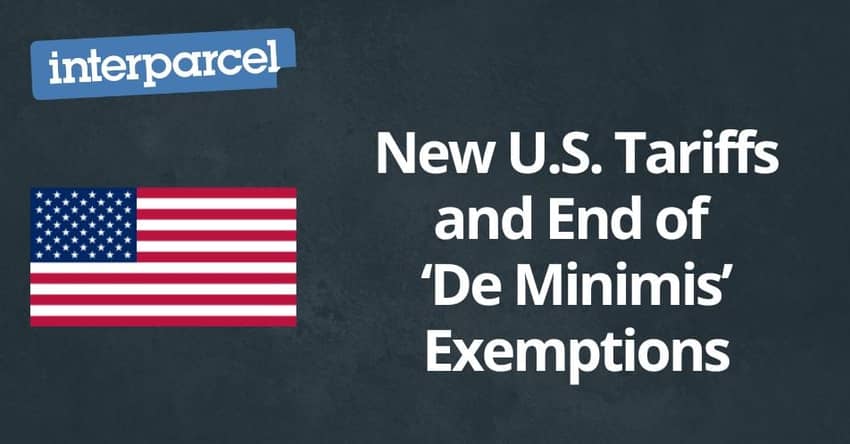If you send parcels to the United States, there are a couple of important changes to be aware of this August.
From August 7th, the U.S. has introduced a new set of import tariffs that apply to goods made in over 60 countries. And from August 29th, the de minimis exemption - which currently allows most low-value shipments to enter duty-free will also be removed.
These updates may affect the total cost of sending items to the U.S., especially if your parcels contain goods made outside the UK or Europe. In this guide, we’ll walk you through what’s changing, what it means for your shipments, and how to prepare.
🔍 Key Point: It’s the Country of Manufacture That Matters
The most important thing to know is that tariffs are based on where the goods were made, not where the parcel is being shipped from.
For example:
If you're sending a parcel from the UK to the U.S., but the item was manufactured in Japan, the Japan-specific tariff rate (15%) applies - not the UK's (10%).
Why this matters:
- U.S. Customs applies tariffs based on the Country of Origin - where the product was substantially manufactured or last significantly altered.
- Warehousing, relabelling or repackaging in a different country doesn’t change the origin.
What to do:
- Accurately declare the true country of manufacture when filling out customs paperwork.
- Inform recipients that import duties will depend on that origin - even if you're sending from a lower-tariff country like the UK.
🌍 Which Countries Are Affected?
The new tariffs range from 10% to 50%, depending on the country and product type. Certain categories, such as semiconductors and pharmaceuticals, may see even higher rates.
Here’s a quick look at how the new tariffs affect key shipping regions:
| COUNTRY OF MANUFACTURE | TARIFF RATE |
|---|---|
| United Kingdom | 10% |
| EU / Japan / South Korea | 15% |
| Brazil | 50% (10% + 40%) |
| Canada | 35% |
| India | 25-50% |
| Switzerland | 39% |
| Laos | 40% |
| Syria | 41% |
| South Africa | 30-39% |
| Pakistan | 19% |
| Iraq | 35% |
| All others (default) | 10% |
Reminder: These rates are based on the manufacturing origin of the goods, not the country where the parcel is sent from.
📦 What This Means for Interparcel Customers
1. Higher Import Costs
Senders and recipients may see increased customs charges, especially for goods made in countries with higher tariff rates. It's important to check the origin before you ship.
2. Review Your Pricing
If you sell to U.S. customers, you may want to review your pricing or delivery options. Being clear about potential import fees can help avoid surprises for buyers.
3. Get the Paperwork Right
Customs processes may be more detailed under the new rules. Be sure to include:
- Correct HS codes
- Clear product descriptions
- Honest item valuations
- The correct country of manufacture
Even if HS codes are optional during the checkout, it is always best practice to include the code. Incomplete or inaccurate paperwork could lead to delays or returns.
4. Think About Your Supply Chain
If you're using stock made in high-tariff countries, you might consider reviewing your suppliers. Keep in mind, though, that customs rules focus on where goods were made - not where they were stored or shipped from.
5. Be Transparent With Customers
If your customer is on the receiving end, it's a good idea to let them know there may be extra charges. This helps build trust and avoids unexpected issues at delivery.
📉 U.S. De Minimis Threshold Ending Soon
Right now, parcels valued under $800 USD can usually enter the U.S. without incurring import taxes or duties. This is called the de minimis exemption, and it’s especially useful for small businesses and individuals sending lower-value items.
But from August 29th, 2025, this exemption will be removed. After that date:
- Even low-value parcels may be subject to U.S. import duties.
- Recipients could start seeing extra charges on orders that would previously have cleared duty-free.
- Senders should clearly communicate potential costs and review pricing or shipping policies where needed.
This change is especially relevant for online retailers or platforms sending high volumes of smaller-value items to U.S. customers.
🧾 Final Tips for Smooth U.S. Shipping
- Double-check the country of manufacture before sending.
- Declare it accurately on your customs paperwork.
- Let your U.S. customers know that customs charges may now apply to more parcels.
- Use Interparcel’s tracking and support tools to stay up to date on your deliveries.
If you need help understanding how these changes affect your shipments - or if you're unsure how to complete your customs declarations - feel free to reach out to our team.










 Facebook
Facebook Twitter
Twitter Instagram
Instagram Linked In
Linked In YouTube
YouTube